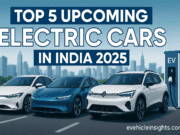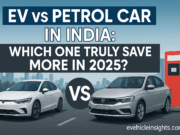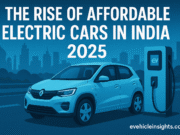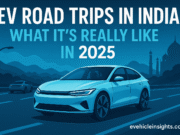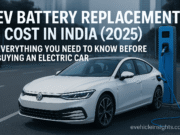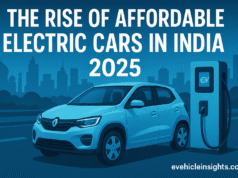Public EV charging infrastructure in India has improved — but it’s still a mixed bag in 2025. Yes, you can survive without a home charger. No, it’s not always smooth. We’ve mapped the truth: real-life usage, charger reliability, urban vs highway setups, and whether “range anxiety” still deserves a place in your vocabulary.
It was somewhere near Nashik, in the middle of a 300-km trip, when I learned a hard lesson about public charging in India.
Google Maps showed a “fast charger” 10 minutes ahead. My Tata Nexon EV was at 14% and counting. I drove in, already imagining the AC and chai while I charged up. Only to find… a dead charger. No error message, no power, no human in sight. Just a machine with more attitude than answers.
I’ll admit it — I panicked a little. But I learned a lot that day. And that’s what this post is about: what public EV charging in India really looks like in 2025.
So, How Many Public Chargers Are There in India Now?
Let’s start with the numbers — and some context.
According to the Ministry of Power’s updated figures:
- Over 11,000 public EV chargers are now operational across India (as of mid-2025)
- Of these, around 4,000+ are fast DC chargers
- Key networks: Tata Power EZ Charge, ChargeZone, Statiq, Ather Grid, BPCL e-Drive, and Jio-bp Pulse
That’s a significant jump from even two years ago. Metro cities like Bengaluru, Mumbai, and Delhi now have chargers every 2–3 km in core areas. But like everything in India, the numbers don’t tell the full story.
The Public Charger Reality: What Works (And What Doesn’t)
Let me break this down from lived experience — not press releases.
What’s Getting Better:
- Charger visibility in apps: PlugShare, Tata Power EZ Charge, and ChargeZone now show live status, connector type, pricing, and availability (most of the time).
- Faster charging speeds: More chargers now support 30kW to 60kW, some even 100kW+ (for EVs like Ioniq 5 or BYD Seal).
- Location quality: Chargers at malls, petrol pumps, cafes = safe, accessible, and waiting-free most of the day.
- Payment via UPI, app wallets, even RFID cards in some hubs.
What’s Still Annoying:
- Broken chargers with no signage or support
- Outdated info on Google Maps
- App bugs, failed payments, or “Session error” messages mid-charge
- Only one working port at a “dual-port” station
- Lack of chargers in Tier-2 and Tier-3 towns
Also, ever tried explaining to a security guard at 11 pm that you just need to “plug your car into the wall”? Yeah, that’s an experience.
Urban vs Highway Charging – Big Difference
Let’s call it like it is:
| Region | Reliability | Availability | Wait Time | Comfort |
| Metro Cities | 7.5/10 | High | Low | Good (AC, food, washrooms) |
| Tier 2 Cities | 5.5/10 | Medium | Medium | Okay-ish |
| Highways | 4/10 | Sparse | High risk | Basic or none |
On highways, you’re often stuck with 1–2 chargers in a 100 km radius. If they’re out, you’re out of luck — unless you’re carrying a 16A plug and an extension cord (been there, done that, still traumatized).
Should You Rely on Public Charging Full-Time?
Honestly? If you:
- Drive <50 km daily
- Have at least 1–2 reliable public chargers nearby
- Can plug in at work, malls, or gyms
…then yes, it’s doable to own an EV without home charging in 2025.
But would I recommend it for peace of mind? Not yet. Not unless your lifestyle is predictable and you’re okay with occasional glitches.
Home Charging Still Wins
Let me say this clearly: If you can install a home charger, do it.
Charging overnight at ₹7/kWh (or less with solar) is unbeatable.
Here’s a simple cost comparison:
| Charging Option | Cost per kWh | Avg Cost/km | Availability |
| Home Charger (AC) | ₹6–₹8 | ₹1.2–₹1.6 | 100% (you control it) |
| Public Fast Charger | ₹16–₹25 | ₹3.5–₹5.5 | 60–70% reliable |
| Petrol Pump | ₹115/litre | ₹7.5–₹8.5 | 99% reliable, but not green! |
If you’re serious about EVs, treat a home charger like you would a phone charger. Essential, not optional.
Charging Apps Worth Downloading
These are the ones I personally use and recommend:
- PlugShare – Crowd-sourced, best for highway planning
- Tata Power EZ Charge – Covers most Tier-1 cities
- Statiq – User-friendly with loyalty points
- ChargeZone – Growing fast on highways
- Ather Grid – Great UI, but limited to Ather locations and scooters
- Jio-bp Pulse – Expanding but still spotty
And yes, always cross-check across 2–3 apps before long trips. That alone can save your weekend.
Future of EV Charging in India (2025–2027 Outlook)
The next two years will be make or break for India’s charging ecosystem. Here’s what’s coming:
- Battery swapping for commercial fleets (Ola, Bounce, etc.)
- Residential apartment charging mandates (already being pushed in Delhi, Mumbai)
- Solar-integrated slow chargers in rural zones
- Hyper-fast charging corridors on Delhi-Mumbai and Chennai-Bengaluru highways
But until that’s all fully live and stress-tested, your best bet is to think hybrid: use home charging + reliable public spots. That’s the winning formula for 2025.
Final Thoughts: Trust, But Verify
The truth is, India’s EV charging story is improving — but it’s not yet frictionless.
Owning an EV in 2025 means being a little bit patient, a little bit smart, and a little bit old-school about planning.
We’re not Norway. Yet. But we’re also not where we were in 2020 — when finding a charger felt like Pokémon Go.
The real question isn’t “Can you rely on public chargers?”
It’s “Are you okay planning ahead to save ₹75,000 a year?” If yes — then welcome to the club.
Stay plugged in (pun intended), and check out tomorrow’s post — we’re breaking down the best electric scooters for Indian roads in 2025.
Till then, charge smart.
— EVehicleInsights

